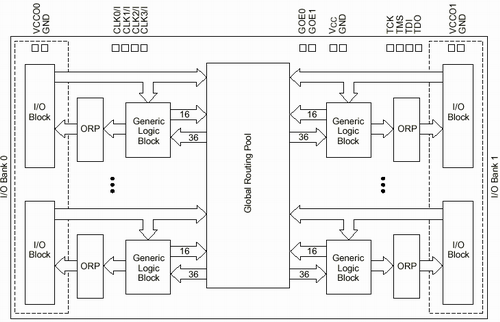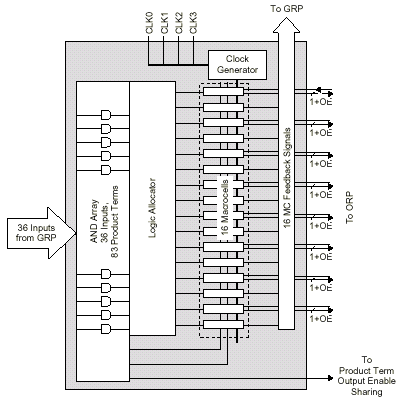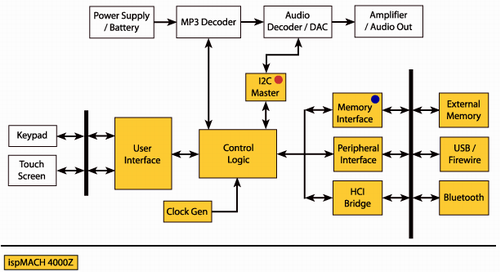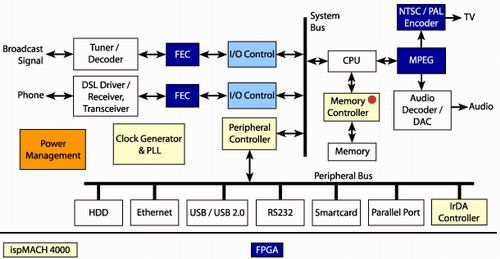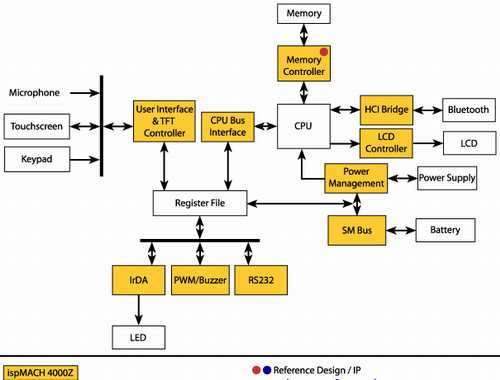Today's programmable devices are moving toward high density, low power, and high speed. Lattice's ispMACH4000Z is the industry's lowest power CPLD device family, offering a new programmable solution for the portable semiconductor consumer market and other electronics markets with high power requirements. This article refers to the address: http:// Traditionally, handheld and portable electronic products have high requirements for low standby power and low cost, thus limiting the use of PLD devices in these products. Lattice Semiconductor's 1.8-volt ispMACH4000ZCPLD family of products is the industry's lowest static power CPLD. The ispMACH4032Z is ​​the first of the first three devices in the ispMACH4000Z family that spans from 32 to 128 macrocells. The quiescent current consumption of these devices is extremely low. For a 32-macrocell device, the worst case is only 20 microamps, which meets the needs of low-power electronics. The new device family's static power consumption is only 20% of the original product. The ispMACH4000Z device not only has the lowest static power in the industry, but also has a low cost. It is very suitable for use in handheld, portable, and other consumer electronics products. The application of programmable logic in these markets has been greatly expanded. Basic structure of the device The ispMACH4000 device consists of multiple GLBs, each with 36 inputs and 16 macrocells. The GLB interconnect is through the Global Routing Pool (GRP). The Output Routing Pool (ORP) connects the GLB to the I/O block. The I/O block contains multiple I/O units. Its structure is shown in Figure 1. The I/O in the device is divided into two zones, each with a different supply voltage. Support for multiple standards allows designers to implement designs in a mixed voltage environment. There are two GLBs in the ispMACH4032, and each GLB has 36 inputs. All GLB inputs come from the global routing pool, and all GLB outputs are returned to the global routing pool to connect to other GLB inputs. If there is a feedback signal back to the same GLB, it must also go through the global wiring pool. This ensures that the GLB communication with each other has a constant predictable delay. The output of the GLB is sent to the output wiring pool and then sent to the I/O unit in the associated I/O block. Figure 1: Function blocks in the device. The GLB consists of a programmable and array, a logic allocator, 16 macrocells and a GLB clock generator. The programmable and array has 36 inputs and 83 output product terms. The 36 inputs from the global routing pool are used to form 72 lines in the array. Each line can be connected by line to any of the 83 output product terms. Each of the 80 logical product terms is fed into the logical allocator, and the remaining three control product terms are fed into the shared PT clock and the shared PTOE. The shared PT clock and the shared PTOE initial signal can be reversed before being sent to the macrocell. Every 5 product terms form a product termcluster. The first product term group is PT0. Each macrocell in the GLB has a product item group. 2 is a structure of a general logic block GLB. Figure 2: General Logic Block GLB. The ispMACH4000 device has two I/O areas, each with its own I/O voltage. The inputs can support a variety of voltages independent of the chip supply voltage or regional voltage. Supporting multiple standard voltages gives designers the design flexibility to accommodate the design needs of today's multiple voltage environments. Application in electronic consumer products The scope of the ispMACH4000Z includes mobile phones and their peripherals, paging devices, GPS positioning devices, PDAs, digital cameras, digital video cameras, personal audio equipment, portable medical instruments, telematics systems and radios, and industrial instruments. Figure 3 shows the application of the ispMACH4000Z in a digital camera. The device implements a graphics controller, an interface between the LCD and IrDA, a memory controller, and an HCI bridge interface between the Bluetooth functional device and the controller. Figure 4 shows the application of the ispMACH4000Z in an MP3 player. The device can implement the memory controller, user interface controller, IrDA controller function, receive remote control data, and HCI bridge interface between the Bluetooth function device and the controller. Figure 5 shows the application of the ispMACH4000Z in a set-top box. The device can implement memory controller, clock distribution and system timing, IrDA controller function, receive remote control data, and implement external device interfaces such as Ethernet, USB, and RS232. Figure 6 shows the application of the ispMACH4000Z in a personal digital assistant. The device enables memory controller, power and smart battery management, HCI bridge interface between Bluetooth function device and controller, IrDA interface, Rs232 interface and LCD controller functions such as TFT timing controller and image rotation. Figure 3: The application of the ispMACH4000Z in digital cameras. Figure 4: The application of the ispMACH4000Z in an MP3 player. Figure 5: Application of the ispMACH4000Z in a set-top box. Figure 6: Application of the ispMACH4000Z in a personal digital assistant (PDA). China factory Junction Boxes Plastic Waterproof Junction Boxes Electrical Junction Box.Factory price plastic waterproof electrical junction box TUV CE Certificate IP67 Wire electronic Junction Box.No patent risk TUV CE Certificate IP67 Wire electronic Junction Box Plastic Junction Box TUV 2 way IP67 outdoor junction box,electronic plastic terminal connecting,waterproof cable junction box,cable connector junction box Guangdong Ojun Technology Co., Ltd. , https://www.ojunconnector.com